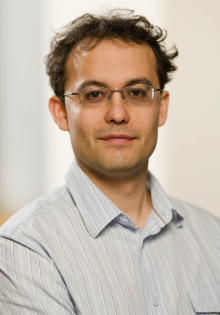In 2018, Prof. Christian Plessl (Chair for High-Performance IT Systems) and Prof. Thomas D. Kühne (Chair for Theoretical Chemistry) have been awarded the Paderborn University Research Award for their project "Green IT: Exact Computations with inexact but energy-efficient computers''. The objective of this interdisciplinary project was to study the feasibility of the "Approximate Computing" paradigm for scientific applications. The main idea is to exploit the capabilities of modern processors and hardware accelerators to execute approximate or low-precision computations at high performance and energy efficiency and to compensate the numerical inaccuracies with novel, error tolerant algorithms. The research initiated by the research award has seeded an intense collaboration between the two research groups and has given rise to several lines of research that are still ongoing.
"Our collaboration and the combination of computational science and computer science has indeed been very fruitful," says Prof. Kühne. "We have for example developed a new method for computing the exact value of physical quantities from data with noise introduced by hardware accelerators and highly scalable, iterative algorithms for computing approximate matrix functions within linear scaling electronic structure calculations."
Selected results from this work have already been incorporated in a review paper on the CP2K program package that just appeared in the Journal of Chemical Physics:
TD Kühne et. al. "CP2K: An electronic structure and molecular dynamics software package - Quickstep: Efficient and accurate electronic structure calculations", J. Chem. Phys. 152, 194103 (2020); doi.org/10.1063/5.0007045
The compensation of noise introduced in computations by approximate computing using a modified Langevin equation has also recently been published:
V Rengaraj, M Lass, C Plessl, TD Kühne. "Accurate Sampling with Noisy Forces from Approximate Computing", Computation 8, 39 (2020); doi.org/10.3390/computation8020039
Prof. Plessl highlights the computer science aspects: "The algorithms we have developed are not only using the Approximate Computing paradigm but are also designed to be highly scalable and optimized for massively parallel processing architectures, in particular FPGAs and GPUs. The results demonstrate that we can achieve results with chemical accuracy despite the inherent approximations. In fact, we are embracing the approximations to achieve higher energy efficiency of computations and will continue this promising path."
The massively parallel, approximate algorithm for iterative matrix function evaluation has been presented at the PASC conference last year and the integration in CP2K with extensions for GPU tensor cores and custom FPGA accelerators has just been published as a pre-print:
- M Lass, S Mohr, H Wiebeler, TD Kühne, C Plessl. "A massively parallel algorithm for the approximate calculation of inverse p-th roots of large sparse matrices.", In Proc. Platform for Advanced Scientific Computing Conference (PASC). ACM, 2018; doi.org/10.1145/3218176.3218231
- M Lass, R Schade, TD Kühne, C Plessl. "A Submatrix-Based Method for Approximate Matrix Function Evaluation in the Quantum Chemistry Code CP2K", arxiv.org/abs/2004.10811
- D Richters, M Lass, A Walther, C Plessl, TD Kühne. "A General Algorithm to Calculate the Inverse Principle p-th Root of Symmetric Positive Definite Matrices.", Commun. Comp. Phys. 25, 564 (2019); doi.org/10.4208/cicp.OA-2018-0053
The implementation of the corresponding methods have been contributed and integrated in the widely-used CP2K (www.cp2k.org) and DBCSR (www.cp2k.org/dbcsr) open source projects. The Paderborn Center for Parallel Computing (PC²) further contributes to this effort with code review and optimization, maintaining the benchmarking (www.cp2k.org/performance) and regression testing infrastructure (dashboard.cp2k.org).
These recent works on methods and libraries for electronic structure theory further strenghten the position of Paderborn University and PC² as nationwide competence center for "atomistic simulations" and major contributors to widely used electronic structure codes and libraries. In addition to CP2K, researchers from Paderborn University and PC² have also contributed to other atomistic simulation codes, such as Quantum ESPRESSO, CP-PAW, ls1-mardyn, ms2, and i-Pi, to name just a few. To foster the atomistic simulations ecosystem and train the next generation of researchers, PC² offers specialized scientific consulting and training (see pc2.uni-paderborn.de/teaching/trainings/hpc-user-trainings/ for upcoming events).




